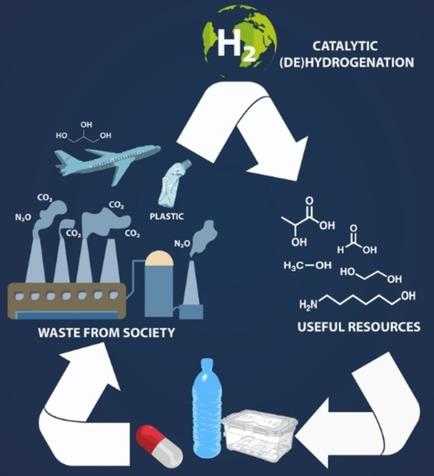当前位置:
X-MOL 学术
›
ChemCatChem
›
论文详情
Our official English website, www.x-mol.net, welcomes your
feedback! (Note: you will need to create a separate account there.)
Homogeneous (De)hydrogenative Catalysis for Circular Chemistry – Using Waste as a Resource
ChemCatChem ( IF 3.8 ) Pub Date : 2020-11-26 , DOI: 10.1002/cctc.202001404 Amit Kumar 1 , Chang Gao 1
ChemCatChem ( IF 3.8 ) Pub Date : 2020-11-26 , DOI: 10.1002/cctc.202001404 Amit Kumar 1 , Chang Gao 1
Affiliation

|
Increasing production and usage of several consumer products and energy sources have resulted in the accumulation of a substantial amount of waste products that are toxic and/or difficult to biodegrade, thus creating a severe threat to our planet. With the recently advocated concepts of circular chemistry, an attractive approach to tackle the challenge of chemical waste reduction is to utilize these waste products as feedstocks for the production of useful chemicals. Catalytic (de)hydrogenation is an atom‐economic, green and sustainable approach in organic synthesis, and several new environmentally benign transformations have been reported using this strategy in the past decade, especially using well‐defined transition metal complexes as catalysts. These discoveries have demonstrated the impact and untapped potential of homogeneous (de)hydrogenative catalysis for the purpose of converting chemical wastes into useful resources. Four types of chemical waste that have been (extensively) studied in recent years for their chemical transformations using homogeneous catalytic (de)hydrogenation are CO2, N2O, plastics, and glycerol. This review article highlights how these chemical wastes can be converted to useful feedstocks using (de)hydrogenative catalysis mediated by well‐defined transition metal complexes and summarizes various types of homogeneous catalysts discovered for this purpose in recent years. Moreover, with examples of hydrogenative depolymerization of plastic waste and the production of virgin plastic via dehydrogenative pathways, we emphasize the potential applications of (de)hydrogenation reactions to facilitate closed‐loop production cycles enabling a circular economy.
中文翻译:

循环化学的均相(脱氢)催化-使用废物作为资源
几种消费产品和能源的生产和使用的增加导致大量有毒和/或难以生物降解的废物的积累,从而对我们的星球造成了严重威胁。利用最近倡导的循环化学概念,解决化学废物减少挑战的一种有吸引力的方法是将这些废物用作生产有用化学物质的原料。催化加氢是有机合成中一种经济,绿色,可持续的原子经济方法,在过去的十年中已报道了使用这种策略的一些新的对环境无害的转变,特别是使用定义明确的过渡金属络合物作为催化剂。这些发现证明了均相(脱氢)催化将化学废物转化为有用资源的影响和未开发的潜力。近年来,通过均相催化(脱氢)加氢进行化学转化的四种化学废物已经得到(广泛)研究。2,N 2 O,塑料和甘油。这篇综述文章重点介绍了如何使用由明确定义的过渡金属络合物介导的(脱氢)催化作用将这些化学废物转化为有用的原料,并总结了近年来为此目的发现的各种类型的均相催化剂。此外,以塑料废物的氢化解聚和通过脱氢途径生产纯净塑料为例,我们强调了(脱)氢化反应在促进闭环生产循环,实现循环经济方面的潜在应用。
更新日期:2020-11-26
中文翻译:

循环化学的均相(脱氢)催化-使用废物作为资源
几种消费产品和能源的生产和使用的增加导致大量有毒和/或难以生物降解的废物的积累,从而对我们的星球造成了严重威胁。利用最近倡导的循环化学概念,解决化学废物减少挑战的一种有吸引力的方法是将这些废物用作生产有用化学物质的原料。催化加氢是有机合成中一种经济,绿色,可持续的原子经济方法,在过去的十年中已报道了使用这种策略的一些新的对环境无害的转变,特别是使用定义明确的过渡金属络合物作为催化剂。这些发现证明了均相(脱氢)催化将化学废物转化为有用资源的影响和未开发的潜力。近年来,通过均相催化(脱氢)加氢进行化学转化的四种化学废物已经得到(广泛)研究。2,N 2 O,塑料和甘油。这篇综述文章重点介绍了如何使用由明确定义的过渡金属络合物介导的(脱氢)催化作用将这些化学废物转化为有用的原料,并总结了近年来为此目的发现的各种类型的均相催化剂。此外,以塑料废物的氢化解聚和通过脱氢途径生产纯净塑料为例,我们强调了(脱)氢化反应在促进闭环生产循环,实现循环经济方面的潜在应用。











































 京公网安备 11010802027423号
京公网安备 11010802027423号